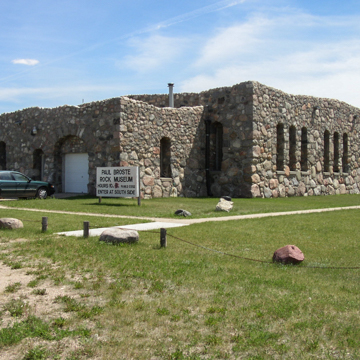This museum is built of granite harvested from the area. The museum was the creation of Broste, a local farmer, artist, and collector, who began his rock collection at an early age and much of it during the 1920s and 1930s, when few people were interested in purchasing rocks. He acquired unusual specimens from all over the world, many of which he cut, ground, and polished into spheres and slabs of great beauty. The museum houses the most significant rock and mineral collection in the state, and many of the specimens are so rare that they may be only found at museums like the Smithsonian Museum of Natural History. Some items, like the fluoride crystals in the collection, cannot be found elsewhere in the world and are deemed priceless. For many years Broste dreamed of housing his collections in a museum, which he characterized as his “Acropolis on a Hill.” The Paul Broste Rock Museum was constructed with volunteer labor and opened to the public in 1965.
You are here
Paul Broste Rock Museum
1965, Paul Broste. 508 N. Main St., Fort Berthold Reservation of the Three Affiliated Tribes
If SAH Archipedia has been useful to you, please consider supporting it.
SAH Archipedia tells the story of the United States through its buildings, landscapes, and cities. This freely available resource empowers the public with authoritative knowledge that deepens their understanding and appreciation of the built environment. But the Society of Architectural Historians, which created SAH Archipedia with University of Virginia Press, needs your support to maintain the high-caliber research, writing, photography, cartography, editing, design, and programming that make SAH Archipedia a trusted online resource available to all who value the history of place, heritage tourism, and learning.















